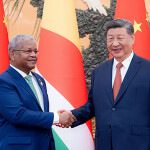I was recently part of a small group of Westerners invited in to a Beijing investment bank, where we were shown screenshots featuring some of the most popular seafood, meat and ready-meal brands in Europe and the United States.
The Chinese analysts giving the presentation were asking for help evaluating the significance of a few carefully chosen brands, including northern and southern European companies with a range of seafood and non-seafood packaged food brands. The depth of their research was apparent as we sat in the building next to the China Banking Regulatory Commission on Jin Rong Jie, Beijing’s equivalent of Wall Street, lined as it is with glass towers all built in the past decade.
Board rooms of investment banks in Beijing, such as the one I recently sat in, are bustling places these days. The bankers are busy drawing up lists of high-value companies and brands in Europe for possible deals. Their lists are then taken to Chinese companies and investors, with the aim of scoring a deal and earning a lucrative transaction fee.
Western seafood firms with proven products and brands are in especially high demand. But Chinese analysts say they struggle to find enough seafood firms of scale with proven brands that are also open to a deal. Fishing companies with trawlers are attractive, but those with brands even more so, the analysts told us.
This matters a lot because this year marks a milestone for China: the first year that overseas direct investment (ODI) will exceed foreign direct investment (FDI) into the country. Chinese ODI is expected to hit USD 1 trillion (EUR 890 billion) by the end of 2016. Chinese investments up to 31 August have already exceeded the total for 2015, according to Mergermarket, a London based consultancy and magazine. Mergermarket reports China spent USD 200 billion (EUR 178 billion) on acquiring overseas firms so far this year.
China’s investments overseas are rising due to a search for yield as the Chinese economy slows. There’s also growing pessimism in China about the lack of action on reform to open up sections of the economy in the choking grip of state-owned enterprises. At the same time, Chinese companies have seen the steady rise of Chinese consumer spending and are also keen on acquisitions to get their hands on know-how, technology and brands (with proven profit yields) to tap this market.
Western countries offer all those. Hence, Europe leads the destination category for Chinese investment for the second year in a row, with totals hitting USD 26.4 billion (EUR 23.5 billion) in 2015, up 10 percent from 2014. Chinese investments to the U.S.A also hit their highest level ever in 2015.
Mergermarket figures vary from those of others, like Luxembourg-based Dragon Capital, which calculates Chinese outbound investments grew by 14.7 percent in 2015, reaching USD 118 billion (EUR 105 billion). Mergermarket puts the total at USD 199.6 billion (EUR 178 billion). But the two organizations are largely on the same page in terms of the key trends and destinations for Chinese outbound investment. Europe accounted for a 45 percent share of Chinese international mergers and acquisitions (M&A) in 2015. These deals range from food and wine companies to Italian tire-maker Pirelli, bought by ChemChina in March 2015.
The other big trend is a big shift away from resources deals, which fell 60 percent in 2015, and an increase in investments by private firms: their investments grew by 51 percent last year, while state owned firms’ spending fell by 9 percent.
Feedback from Chinese investment bankers suggests Chinese advances (and investments) are often very welcomed by target companies who agree to a majority- (77 percent of all outbound Chinese M&A deals) or minority-stake sale. That’s because they want to establish strategic partnerships with Chinese investors to give their companies entry to the Chinese market.
Other key pitches made by Chinese advisors to a targeted Western target firm are investment, and especially spending on R&D. Incredibly, Chinese firms are often keen to use overseas acquisitions to conduct product development in order to avoid the patchy Chinese legal environment (particularly where intellectual property is concerned).
Many of the potential Chinese buyers are not necessarily seafood firms, as debt weighs particularly heavy on the sector – but are often Chinese industrial conglomerates seeking to diversify away from unprofitable and over-crowded core industries.
Chinese outbound M&A will continue to pick up because several economic factors at home cloud the future of the Chinese economy. There’s an inevitable rise in costs (and a likely corresponding rise in incomes) as China’s working-age population will fall by 0.5 percent per year for the next 20 years. And there’s the possibility of a financial crisis, given the increasing but uncertain scale of bad debt at Chinese banks.
In the absence of serious reforms that reinvigorate investors’ interest in China, it’s inevitable that money will continue to venture overseas. Chinese officials are in a contradictory bind between supressing interest rates in order to stoke the economy, while also keeping a large swathe of zombie firms alive at the same time they’re trying to stem the outflow of money seeking better returns overseas.
This is the era of the Chinese buyout and it’s a trend seafood executives will notice sooner rather than later.






